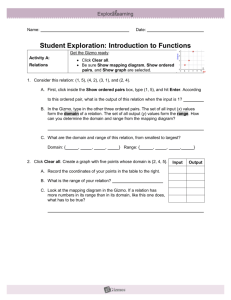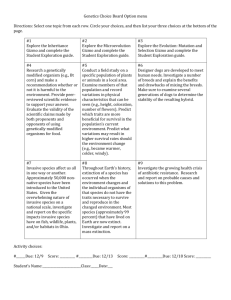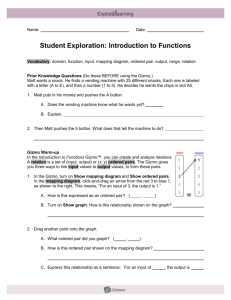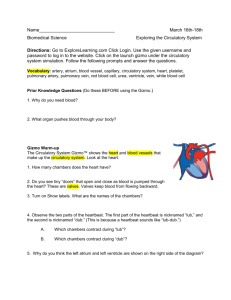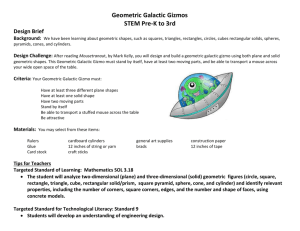Technical Manual for
advertisement
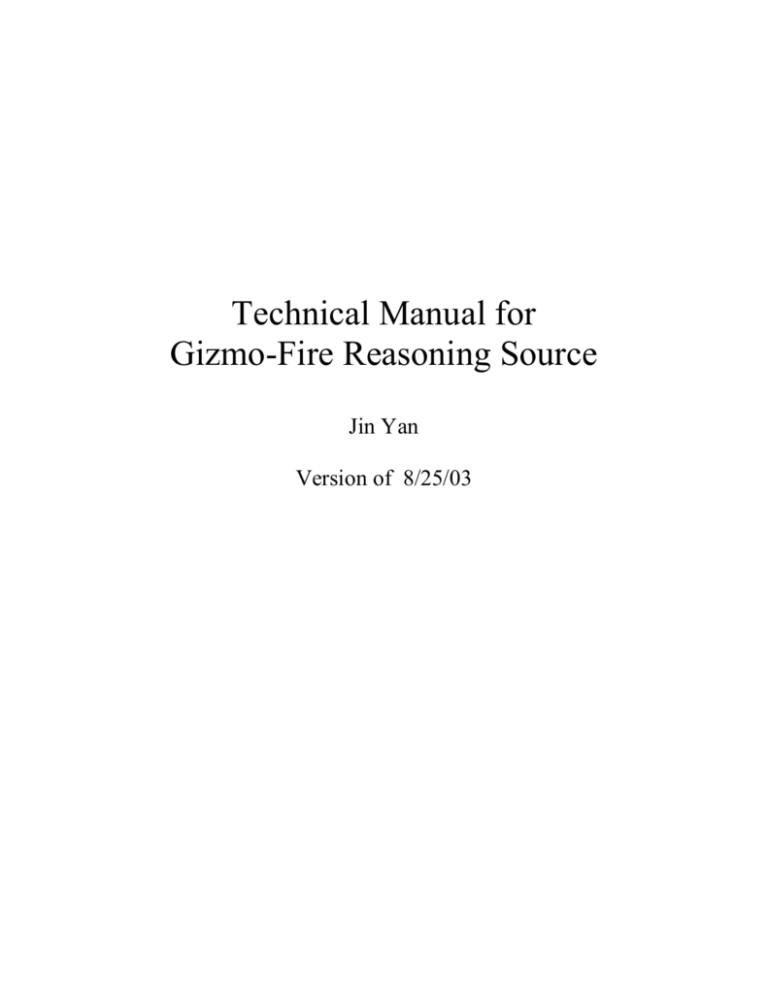
Technical Manual for Gizmo-Fire Reasoning Source Jin Yan Version of 8/25/03 1 INTRODUCTION................................................................................................................. 3 2 ACCESSING GIZMO-FIRE REASONING FACILITIES .............................................. 3 3 USEFUL QUERIES AND COMMANDS FOR QUALITATIVE REASONING .......... 3 3.1 3.2 3.3 3.4 3.5 START A QP ANALYSIS ..................................................................................................... 4 RESOLVE INFLUENCES ..................................................................................................... 4 LIMITED ANALYSIS .......................................................................................................... 4 ENVISIONMENT ................................................................................................................ 4 INSPECTING RESULTS OF QUALITATIVE REASONING ......................................................... 5 4 AN EXAMPLE INTERACTION WITH THE REASONING SOURCE ....................... 6 5 TROUBLESHOOTING ....................................................................................................... 7 6 ACKNOWLEDGEMENTS ................................................................................................. 7 7 REFERENCES ...................................................................................................................... 7 2 1 Introduction Sources in FIRE make it possible to do reasoning and fact lookup that lying outside of its usual reasoning mechanisms. So far, FIRE has had source interfaces to several other facilities and information sources, such as: analogical matching software (SME) and spatial reasoners. How could we make this federated architecture more powerful to support more reasoning facilities? One of the complex reasoning systems, Gizmo, uses QP theory (Forbus, 1984) to do qualitative reasoning about changes observed in physical situations based on common sense knowledge. Bridging FIRE with Gizmo could provide FIRE those qualitative reasoning facilities Gizmo possesses and make it more powerful. This motivated building in qualitative processing into FIRE in terms of its basic capabilities. The interaction with Gizmo facilities is carried out by using queries expressed in the QP ontology, a vocabulary of entities and predicates that reifies the concepts of QP theory. Gizmo is grafted into FIRE with no changes to itself. It is the Gizmo-Fire reasoning source calls Gizmo procedures and supports interoperation. This is a preliminary draft of documentation describing the Gizmo-Fire reasoning source built into FIRE. We are making this draft documentation available to support those who wish to experiment with these facilities as they evolve. 2 Accessing Gizmo-Fire reasoning facilities In order to start a gizmo reasoning session, please follow the steps below: 1) Load Fire and Gizmo. 2) Open a KB by using: (fire::make-kb ARGUMENTS). For example, you could open qrg-general database by calling: (fire::make-kb “c:\\qrg\\fire\\kbs\\qrg-general” “qrg-general”) 3) Load necessary knowledge to the KB either by calling: (fire::meld-file->kb FILE-NAME) (note: the file here is a meld file) or by calling (fire::flat-file->kb FILE-NAME) (while the file in this case is a flat file). 4) Load gizmo-fire reasoning source: load defsys.lsp file in c:\\qrg\\fire\\v1\\gizmo\\v2 directory. Then call (load-gizmo-fire) 5) Make a reasoner by calling: (fire::make-gizmo-fire-reasoner). 6) Don’t forget to close the KB when you are ready to exit Lisp, by calling: (fire::close-kb). 3 Useful queries and commands for qualitative reasoning All of these queries are made via using an ask message, as introduced in the FIRE manual. In each case we give forms for knowledge bases whose predicate-style is mixed-case and hyphen. MC will precede the mixed-case form and HY will precede the hyphenated form. 3 3.1 Start a QP analysis Qualitative analysis is carried out using functions under Gizmo. Each primitive QP analysis for a scenario based on a general domain-theory results in the creation of a Gizmo object to represent the analysis, which is returned as one of the variables bound by the query. MC: (qpAnalysisOf <scenario> <domain-theory> <assumptions> <?gizmo>) HY: (qp-analysis-of <scenario> <domain-theory> <assumptions> <?gizmo>) Where <scenario> is the scenario description for the qp analysis and <domain-theory> is the domain theory description for the analysis. Both <scenario> and <domain-theory> must be fully bound. <scenario> and <domain-theory> can be any case, we currently support (ExplicitCaseFn <case-name>) [or (explicit-case-fn <case-name>) if hyphenated] and (MinimalCaseFn <case-name>) [or (minimal-case-fn <case-name>)]. (ExplicitCaseFn <casename>) refers to explicitly stored cases, (MinimalCaseFn <case-name>) refers to dynamic constructed cases. <assumptions> is a set of statements assumed for the qp analysis. It can be nil or specified via a list. <?gizmo> is bound to a reference to the copy of Gizmo used in the match, so that information about the Gizmo can be extracted. 3.2 Resolve Influences MC: (qpStatesConsistentWith <constraints> <gizmo> <?states>) HY: (qp-states-consistent-with <constraints> <gizmo> <?states>) Given <constraints>, statement(s) assumed to LTRE, and a gizmo <gizmo>, this query binds <?states> to the consistent states returned by carrying out functions around resolve influences under Gizmo. 3.3 Limited Analysis MC: (qpStateTransitionTo <state> <?state>) HY: (qp-state-transition-to <state> <?state>) Given this query, Gizmo will carry out limited analysis and find state transitions for the given <state>. <?state> is bound to the next state. 3.4 Envisionment MC: (qpEnvisionment <gizmo>) HY: (qp-envisionment <gizmo>) This query will make Gizmo carry out the envisioning process of generating an envisionment, e.g., generating all possible behaviors. Although this query doesn’t have any results returned, the byproducts of envisionment are reified and further queries of inspecting the results are supported. 4 3.5 Inspecting results of qualitative reasoning The reified terms used to refer to aspects of qp analysis are designed for efficiency and convenience during problem solving. Specifically, we use: MC: (QpAnalysisFn <id>) HY: (qp-analysis-fn <id>) specifies a qp analysis, i.e., a copy of gizmo used to do qualitative reasoning for a specific scenario based on a domain theory. <id> is an integer, it equals to the object gizmo’s id number. MC: (QpStateFn <state-id> <gizmo-id>) HY: (qp-state-fn <state-id> <gizmo-id>) specifies a state. The <id> is an implementation-specific integer ID, incremented whenever a state for gizmo <gizmo id> is created. MC: (stateViewStructure <state> <view structures>) HY: (state-view-structure <state> <view structures>) Indicates that <view structure> is a list of view structures associated with the <state>. MC: (stateProcessStructure <state> <process structures>) HY: (state-process-structure <state> <process structures>) Indicates that <process structure> is a list of process structures associated with the <state>. MC: (stateDsValues <state> <ds values>) HY: (state-ds-values <state> <ds values>) Indicates that <ds values > is a list of ds values associated with the <state>. MC: (stateQuantities <state> <quantities>) HY: (state-quantities <state> <quantities>) Indicates that <quantities> is a list of quantities associated with the <state>. MC: (stateOrdinalRelations <state> <ordinal relations>) HY: (state-ordinal-relations <state> <ordinal relations>) Indicates that <ordinal relations > is a list of ordinal relations associated with the <state>. MC: (stateInfluences <state> <influences>) HY: (state-influences <state> <influences>) Indicates that <influences> is a list of direct and indirect influences associated with the <state>. MC: (stateContinuityConstraints <state> <continuity constraints>) HY: (state-continuity-constraints <state> <continuity constraints>) Indicates that <continuity constraints> is a list of continuity constraints associated with the <state>. MC: (stateAssumptions <state> <assumptions>) 5 HY: (state-assumptions <state> <assumptions>) Indicates that <assumptions> is a list of assumptions associated with the <state>. MC: (stateStatus <state> <status>) HY: (state-status <state> <status>) Indicates that <status> is a list of process structures associated with the <state>. 4 An example interaction with the reasoning source Capabilities that are not implemented do not have examples, and will be marked as such below. ;;Start a QP analysis cl-user(18): (fire:ask-it '(qpAnalysisOf (minimalCaseFn TwoContainers) (minimalCaseFn NaiveSteamDomainTheory) nil ?gizmo)) ((qpAnalysisOf (minimalCaseFn TwoContainers) (minimalCaseFn NaiveSteamDomainTheory) nil (QpAnalysisFn 2))) ;;Resolve influences cl-user(19): (fire:ask-it '(qpStatesConsistentWith ((aligned P1)) (QpAnalysisFn 2) ?states) ((qpStatesConsistentWith ((aligned P1)) (QpAnalysisFn 2) ((QpStateFn 80 2) (QpStateFn 79 2) (QpStateFn 78 2) (QpStateFn 77 2) (QpStateFn 76 2) (QpStateFn 75 2) (QpStateFn 74 2) (QpStateFn 73 2) (QpStateFn 72 2) (QpStateFn 71 2) ...))) ;;Limited analysis.. cl-user(20): (fire:ask-it '(qpStateTransitionTo (QpStateFn 1 2) (QpAnalysisFn 2) ?next-state)) ((qpStateTransitionTo (QpStateFn 1 2) (QpAnalysisFn 2) (QpStateFn 13 2))) ;;Inspect results cl-user(21): (fire::ask-it '(stateViewStructure (QpStateFn 3 2) ?view-structures)) ((stateViewStructure (QpStateFn 3 2) (TheList (active Wf) (:not (active Wg)) (active MF0) (active MF1) (active MF2) (active MF3) (active MF4) (active MF5)))) cl-user(22): (fire::ask-it '(stateDsValues (QpStateFn 3 2) ?ds-values)) ((stateDsValues (QpStateFn 3 2) (TheList (= (d (AmountOf Water Gas F)) 0) (= (d (AmountOf Water Gas G)) 0) (= (d (AmountOf Water Liquid F)) 0) (= (d (AmountOf Water Liquid G)) 0) (= (d (BottomHeight F)) 0) (= (d (BottomHeight G)) 0) (= (d (Density Water)) 0) (= (d (Heat MF4)) 0) (= (d (Heat MF5)) 0) (= (d (Heat Water)) 0) (= (d (Heat Wf)) 0) (= (d (Mass MF4)) 0) (= (d (Mass MF5)) 0) (= (d (Mass Wf)) 0) (= (d (MaxHeight P1)) 0) 6 (= (= (= (= (= (= (d (d (d (d (d (d (Pressure MF4)) 0) (= (d (Pressure MF5)) 0) (= (d (Pressure Wf)) 0) (TBoil Water F)) 0) (= (d (TBoil Water G)) 0) (Temperature MF4)) 0) (= (d (Temperature MF5)) 0) (Temperature Wf)) 0) (= (d (ThermalConductivity Water)) 0) (TopHeight F)) 0) (= (d (TopHeight G)) 0) (= (d (Volume MF4)) 0) (Volume MF5)) 0) (= (d (Volume Wf)) 0)))) cl-user(22): (fire::ask-it '(stateQuantities (QpStateFn 3 2) ?quantities)) ((stateQuantities (QpStateFn 3 2) (TheList ((BottomHeight F) (TopHeight F) (MaxHeight P1) (Density Water) (Heat Water) (ThermalConductivity Water) (BottomHeight G) (TopHeight G) (Mass Wf) (AmountOf Water Liquid G) (AmountOf Water Liquid F) (Tboil Water G) (TBoil Water F) (Temperature Wf) (AmountOf Water Gas G) (AmountOf Water Gas F) (Mass MF4) (Mass MF5) (Heat Wf) (Pressure Wf) (Volume Wf) (Heat MF4) (Temperature MF4) (Heat MF5) (Temperature MF5) (Pressure MF4) (Volume MF4) (Pressure MF5) (Volume MF5)) 5 Troubleshooting Every time the circle of users is widened, new bugs are found. We appreciate your help in improving these capabilities. 6 Acknowledgements This work is supported by DARPA under the Command Post of the Future and Rapid Knowledge Formation programs. 7 References To be added 7
